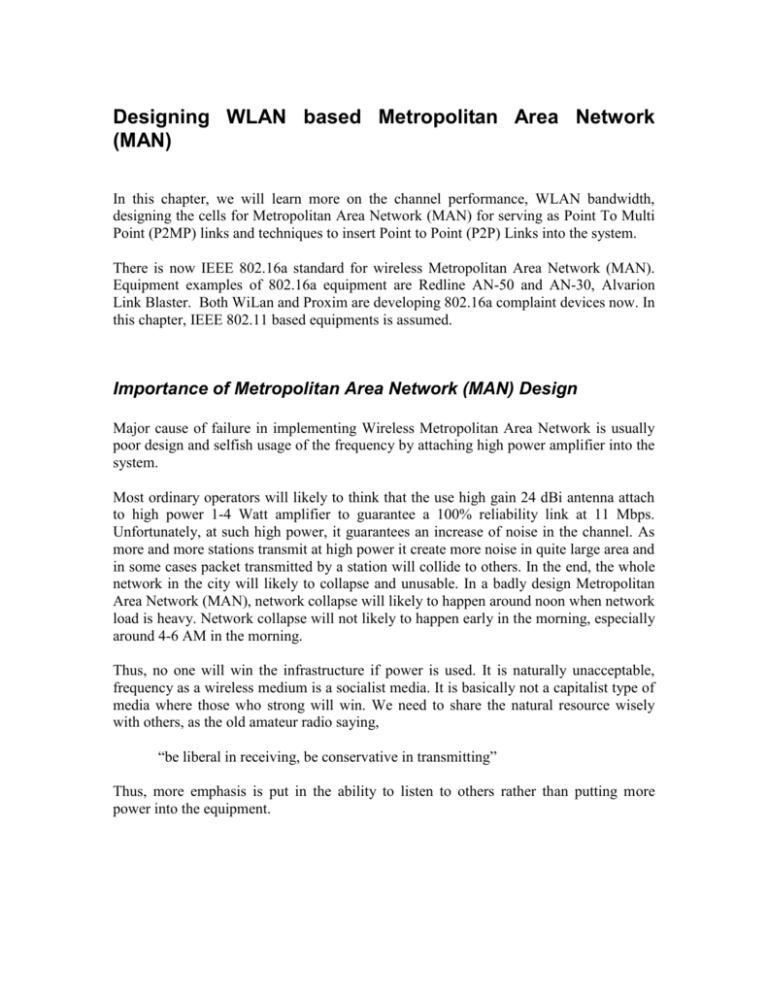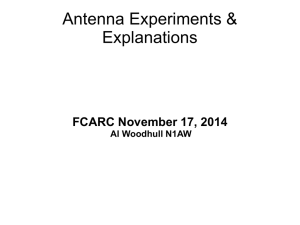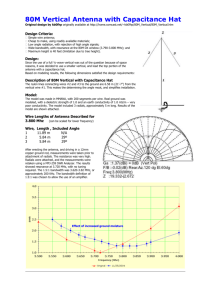Designing WLAN based Metropolitan Area Network (MAN)
advertisement

Designing WLAN based Metropolitan Area Network (MAN) In this chapter, we will learn more on the channel performance, WLAN bandwidth, designing the cells for Metropolitan Area Network (MAN) for serving as Point To Multi Point (P2MP) links and techniques to insert Point to Point (P2P) Links into the system. There is now IEEE 802.16a standard for wireless Metropolitan Area Network (MAN). Equipment examples of 802.16a equipment are Redline AN-50 and AN-30, Alvarion Link Blaster. Both WiLan and Proxim are developing 802.16a complaint devices now. In this chapter, IEEE 802.11 based equipments is assumed. Importance of Metropolitan Area Network (MAN) Design Major cause of failure in implementing Wireless Metropolitan Area Network is usually poor design and selfish usage of the frequency by attaching high power amplifier into the system. Most ordinary operators will likely to think that the use high gain 24 dBi antenna attach to high power 1-4 Watt amplifier to guarantee a 100% reliability link at 11 Mbps. Unfortunately, at such high power, it guarantees an increase of noise in the channel. As more and more stations transmit at high power it create more noise in quite large area and in some cases packet transmitted by a station will collide to others. In the end, the whole network in the city will likely to collapse and unusable. In a badly design Metropolitan Area Network (MAN), network collapse will likely to happen around noon when network load is heavy. Network collapse will not likely to happen early in the morning, especially around 4-6 AM in the morning. Thus, no one will win the infrastructure if power is used. It is naturally unacceptable, frequency as a wireless medium is a socialist media. It is basically not a capitalist type of media where those who strong will win. We need to share the natural resource wisely with others, as the old amateur radio saying, “be liberal in receiving, be conservative in transmitting” Thus, more emphasis is put in the ability to listen to others rather than putting more power into the equipment. Channel Performance Under Load To give some ballpark figure on the system, a short calculation on the throughput will be demonstrated. IEEE 802.11 based equipment is mostly a half-duplex radio system. It means it cannot simultaneously transmit and receive. Consequently, the actual throughput is not 11Mbps, rather around a maximum of 6-7 Mbps. The actual throughput is somewhat lower as some of the time is consumed by overhead protocol and time for the radio to switch between transmitter and receiver. Thus, it is likely to see a maximum of 56 Mbps (or about 600-800Kbyte per second) actual throughput in the overall system. We will likely to see such maximum throughput if only two (2) stations communicating through the channel. Unfortunately, WiFi is a shared infrastructure. It means only one station can use the frequency at a time. More station uses the channel more time delay for each station before it can use the channel. Thus, it is logical to see a drop in channel throughput per station as more station use the same frequency. More degradation in the throughput will likely to be more apparent if more station downloading or uploading large file, such as, high e-mail traffic, high FTP or downloading files from the Web. The system will experience less degradation for low traffic, and, thus, more station can be accommodated. As shown in the figure, the maximum number of stations can share the same frequency is fairly limited and depending the type of traffic. At low traffic, we are looking at a maximum of 30 stations before we see a significant drop in the throughput. While at high traffic, the channel may hold only a limited number of stations (around 10-15 stations) before a significant drop is apparent. Thus, we need to limit to around 10-30 stations In such condition, one should reuse the frequency after certain distance. Thus, limiting the power for each station to create a cell of maximum 20-30 stations for each channel is essential. Thus, confirming to 36 dBm EIRP is significantly important to assure frequency reuse in the area. Note that the station within one cell (with one channel) may have different ESSID. It has nothing to do with the number of Access Point in the cell. The maxim number of stations remains around 20-30 stations; no matter how many Access Points serve each cell. We should also design the frequency correctly to minimize the interference between each cell. An orthogonal channel set should be used to provide enough frequency separation to co-locate several RF links in the band without interfering with each other. Channel in WiFi Infrastructure WiFi infrastructure has basically very limited channels. In a crowded traffic, not all channel can be simultaneously used in order to minimize interference in the infrastructure. Channel 1 2 3 4 5 6 7 Frequency 2412 MHz 2417 MHz 2422 MHz 2427 MHz 2432 MHz 2437 MHz 2442 MHz Channel 8 9 10 11 12 13 14 Frequency 2447 MHz 2452 MHz 2457 MHz 2462 MHz 2467 MHz 2472 MHz 2477 MHz Note that not all channels can be used in all countries. For example, North American (US & Canada) can only use channel 1-11. European uses channel 1-13. Japan uses channel 14. It highly depends on the regulation in each country. For IEEE 802.11b based WiFi infrastructure uses Direct Sequence Spread Spectrum (DSSS), we are looking at about 22 MHz of bandwidth for each transmitted station. It means for a station transmitted on channel one (1) or 2412 MHz center frequency. It will occupy 11 MHz below the center frequency as well as 11 MHz above the center frequency. It unfortunately means it will occupy two (2) channels up, two (2) channels down or five (5) channels in total. Consequently, to minimize interference in the channel, the community should clear two (2) channels up, and two (2) channels down. Orthogonal Channel Set An orthogonal channel set is a set of channel that provides enough frequency separation to co-locate several RF links without interfering with each other. From the spectrum analyzer measurement presented by Waverider (http://www.waverider.co m), it clearly shows that three (3) co-locate RF links running at 2412 MHz, 2437 MHz, and 2462 MHz does not interfere to each other. In the North America, people stuck with maximum of 11 channels. However, in other countries, some may use up to 14 channels. Thus, orthogonal channel sets may be differe nt for such countr ies. Depen ding on the accept able interfe rence tolera nce, one may have four (4) orthogonal channels if a slight interference is acceptable at the edge of the spectrum. For better separation or due to regulation restriction, one may choose three (3) orthogonal channel sets, namely, Channel 1 Channel 6 Channel 11 2412 MHz 2437 MHz 2462 MHz However, for those fortunate enough with access to full 14 channel sets, one may allow a little bit of interference and uses four (4) orthogonal channel sets Channel 1 Channel 5 Channel 9 Channel 13 2412 MHz 2432 MHz 2452 MHz 2472 MHz It may not have enough channel separation. However, it is better for dense areas as it give us the ability to build an additional cell on channel 13. Please note that four (4) orthogonal channel setting may not be able to be implemented using US equipments. One may have to look for Taiwanese equipments for such WiFi infrastructure. Range of WLAN Transmission With limited Effective Isotropic Radiated Power (EIRP) to 30-36 dBm, we are looking at limited range of WLAN transmission. The maximum transmission range by allowing 10-15 dB operating (fade) margin is highly depends on the type of antenna used at the Access Point. If an omni-directional antenna @ 1012 dBi gain used, we are looking at 4-5 km range of the communication points. While if a sectoral antenna @ 12-14dBi gain is used at the Access Point, we are looking at 6-8 km distances for communication. Thus, we may set cells of stations within 4-5 km radius for Access Point with omnidirectional antennas or within 6-8 km diameter for Access Point with sectoral antennas. While understanding that a cell will have a maximum of 10-30 station in it, we may need to break up the cell into set micro cells if the number of stations quite large (more than 30) within an area. Reducing the EIRP & gain of the antenna may easily perform break a large cell into micro cells. To maximize system performance we have to attempt to maximize received signal and minimize any noise and interference on the channel that in return will maximize the Signal to Noise Ratio (SNR). Modeling The Radio Coverage Boundary Having the knowledge on the radio propagation calculation, orthogonal channel sets, and antenna radiation pattern, our next step would be modeling the radio coverage for certain type of antenna to be able to design the cell arrangement in a Wireless Metropolitan Area Network. A Access Point (AP) with omnidirectional antenna will theoretically have a circle radio coverage around 4-5 km radius depending on the radio configuration. Thus, the cell boundary is theoretically circle. However, for modeling multiple cells Metropolitan Area Network (MAN), it would be easier to view the radio coverage as a hexagonal ideal cell boundary rather than circle cell boundary. The Access Point is located right in the middle of the hexagon. In reality, not all area within the cell boundary can be covered as we may have some blank spots in the areas. Furthermore, radio signal may also reach some areas outside the cell boundary. The actual coverage is represented in dotted areas in the figure. If a sectoral antenna used at the Access Point (AP), it may have a main lobe will covering about 6-8 km going out of the antenna direction. For modeling multiple cells Metropolitan Area Network (MAN) with three (3) orthogonal channel set, it would be easier to model it into a hexagonal coverage with the Access Point located at one end of the hexagonal. It is assumed a 120 degree horizontal beam width sectoral antenna is used. Similarly to Access Point with omnidirectional antenna, the actual coverage is subject to blank spots in the area. If four (4) orthogonal channel set is used. A sectoral antenna will likely to be used at the Access Point. It may be so much easier if the coverage boundary is modeled in square boundary with the Access Point located at one tip of the square boundary. Metropolitan Area Network (MAN) Design Based on 3 Orthogonal Channel Set Omnidirectional Access Point In this section, we will use the hexagonal boundary model for three (3) orthogonal channels set, namely, channel 1, 6 and 11. Since we want all cells not to overlap one to another, the logical arrangement of the cell would be something shown in the figure. Cell running on channel 1 is colored in blue; channel 6 in green, and channel 11 in yellow, respectively. As clearly shown, Access Point of cell with the same channel is separated by about 15 km apart. Consequently, the interference among cells is minimized as the transmission range of the Access Point at 36 dBm limited to only about 4-5 km. Shown in the figure is an example of Metropolitan Area Network (MAN) with seven (7) cells. It covers an area / city of about 35 x 35 km square. If one cell holds about 10-30 stations, it means we are looking at an WiFi infrastructure that capable to serve about 70210 stations depending on the traffic. The WiFi infrastructure can then be used to connect the local neighborhood network into the Internet, and, thus, the total computers connected to the Internet are significantly larger than the total WiFi stations. Unfortunately, since an omnidirectional antenna is used, it requires seven (7) towers to hold those seven (7) Access Points. It is not the most efficient way to build the Metropolitan Area Network (MAN). Sectoral Access Point If sectoral antenna used at the Access Point, the three (3) Access Point with three (3) orthogonal channels set on the same single tower. Each sectoral antenna connected to one of the Access Point (AP). The three (3) sectoral antennas are aiming 120 degree apart from a single tower. Each sectoral antenna will cover an distance of 6-8 km. The setting is visualized in the figure. Depending on the traffic, the number of WiFi station in each cell is limited to 10-30 stations. Since the WiFi stations are normally used as the gateway for local neighborhood network, the total computers connected to the network are significantly larger than the total WiFi stations. To cover fairly similar areas, well in fact a bit larger area than that omnidirectional antenna Access Point, more than 35 x 35 km square can be covered in nine cells as shown in the figure. Cell running on channel 1 is colored in blue; channel 6 in green, and channel 11 in red, respectively. The important feature of the configuration, it requires much less number of towers, i.e, only three (3) towers for nine (9) cells. Having more cells, the number of WiFi stations will also increased. Thus, serve much more computers for less number of towers. Metropolitan Area Network (MAN) Design Based on 4 Orthogonal Channel An effective implementation of WiFi infrastructure based on four (4) orthogonal channel set as shown earlier can be modeled using a square. 90-degree sectoral antenna is normally used at the Access Point. The four (4) Access Point running on four (4) orthogonal channels are on the same single tower. Each sectoral antenna connected to one of the Access Point (AP). The four (4) sectoral antennas are aiming 90 degree apart. Each sectoral antenna will cover a distance of 6-8 km sometimes longer. The setting is visualized in the figure Cell running on channel 1 is colored in blue; channel 5 in green, channel 9 in yellow, and channel 13 in red, respectively. Logically, four (4) orthogonal channel set will likely to cover a much larger areas as compared to the previous configuratio n. The important feature of the configuratio n, it requires much less tower, i.e, only four (4) towers for twelve (12) cells. Having more cells, the number of WiFi stations will also increased. Thus, serve much more computers for much less tower. It will significantly reduce the total investment and operating costs. Insertion of Point To Point (P2P) Links In some cases, we need to use Point-to-Point (P2P) links in our communication links, for example, the link between main offices to its branch. These Point-to-Point (P2P) links must share the same frequency as other wireless links in the area specially the Point To Multi Point (P2MP) link. Keep in mind that we need to minimize the interference from P2P links on the P2MP links. Note that most of the Point-to-Multi-Point (P2MP) links will likely to use omnidirectional or sectoral antenna at the Access Point. It is normally a vertically polarized antenna. One of the simplest trick to minimize interference of the P2P links on the P2MP links are by, Using different antenna polarization. P2MP links are normally using vertical polariztion. By using horizontal polarization for P2P links, we will normally have around 25 dB signal separations. It is quite large for a signal. Set P2P channel in between two (2) orthogonal channels that used by P2MP links. For a three (3) orthogonal channel set, the Point-to-Point (P2P) channel will be, Channel 3 Channel 8 2422 MHz 2447 MHz For a four (4) orthogonal channel set, the Point-to-Point (P2P) channels are Channel 3 Channel 7 Channel 11 2422 MHz 2442 MHz 2462 MHz We may have 25 dB separations between vertical and horizontal polarization antenna. Since the frequency in four (4) orthogonal channels is quite crowded, P2P links may add noticeable noise into the system. Shown in the figure is an example of the band with P2P inserted in between the P2MP links running on the orthogonal channel. The figure shows the example of two (2) P2P links inserted into three (3) P2MP cell. It does not do much harm into the system. Using different polarization and different channel has reduced the interference. Some Note on Antenna Polarization Antenna polarization can be useful not only for inserting point-to-point (P2P) links into point-to-multi-point (P2MP) links. Knowing 20-25 dB separations between vertical and horizontal polarized signal, some operators use horizontally polarized point-to-multipoint (P2MP) links. Assuming no one uses horizontal polarized point-to-point (P2P) links in the area. Thus, it is basically doubling the system capacity. We may also increase the channel capacity by overlapping different polarization on the same channel, same area. To minimize noise and interference, vertical separation of the antenna from two (2) different systems should be use to make sure enough isolation among the system. Some of my friends, such as, Henry (henry@cgd.co.id), have been frustrated for sometime as both vertical and horizontal polarization links are fully loaded in his area. Their group has been playing around with 45-degree polarization link, especially for point-to-point (P2P) links. Although the signal separation is much lower than 20 dB, it surprisingly works in their case. Some Note on Sectoral Areas We may have more than four (4) sector system co-located in one tower. It is depending on the antenna pattern and frequency availability. When we choose to build a sectorized access point, we gain the following advantages. Scalability – we may increase the capacity of our system. We may always start small with a single sector serving a few users. As number of user grows, we can add more sectors. By converting a single omnidirectional coverage to three-sector coverage, we basically triple the system capacity and so on. Reliability – we can select the gain and antenna pattern of each sector to provide the highest reliability to the user in particular sector. We can also downtilt the antenna to reduce interference from other networks. By correctly designing a good sector antenna and installing the sector antennas, we may reduce the noise level and improve the reliability of the service within the sector. Cell Interconnection Major problem in cellular arrangement Metropolitan Area Network (MAN) is in constructing the trunk backbone for linking the cells especially in remote areas. Actually, we have many options to do it, such as, Uses channel 13 as Point-to-Point (P2P) backbone trunk, while use channel 1, 5 and 9 for user access Point-to-Multi-Point (P2MP) links. Uses IEEE 802.11a equipment running on 5.8GHz band. Uses ADSL or other DSL families via two-wire cable. Uses VSAT for longer distances.




